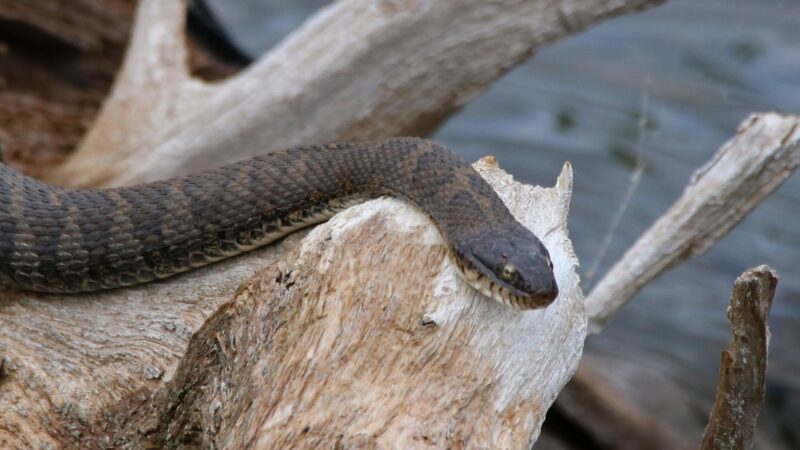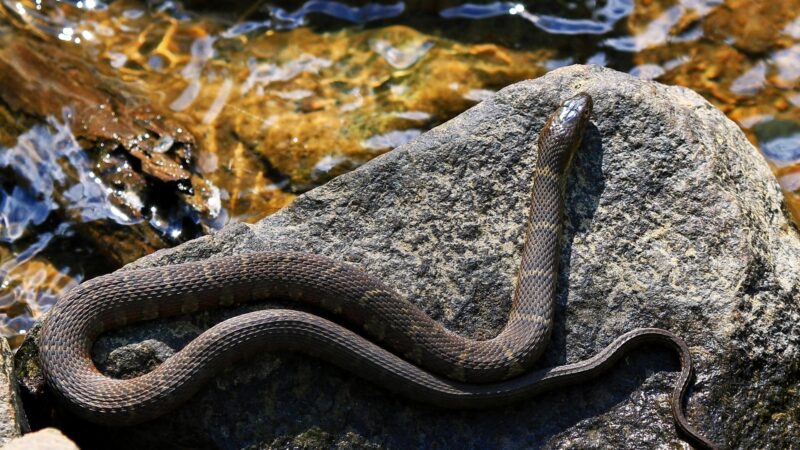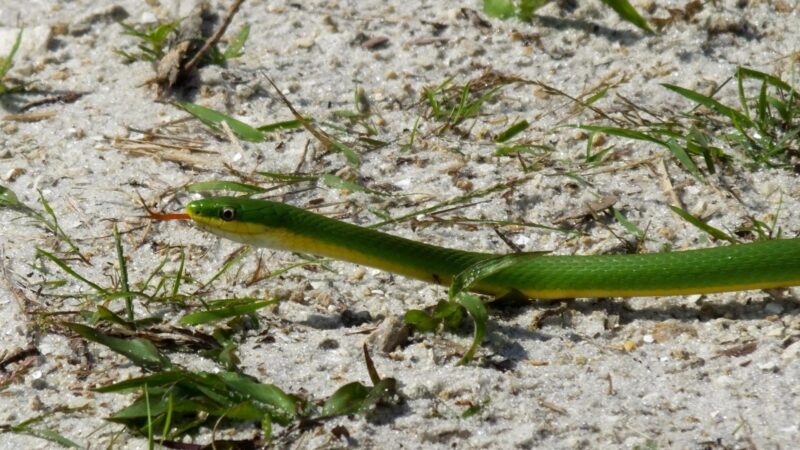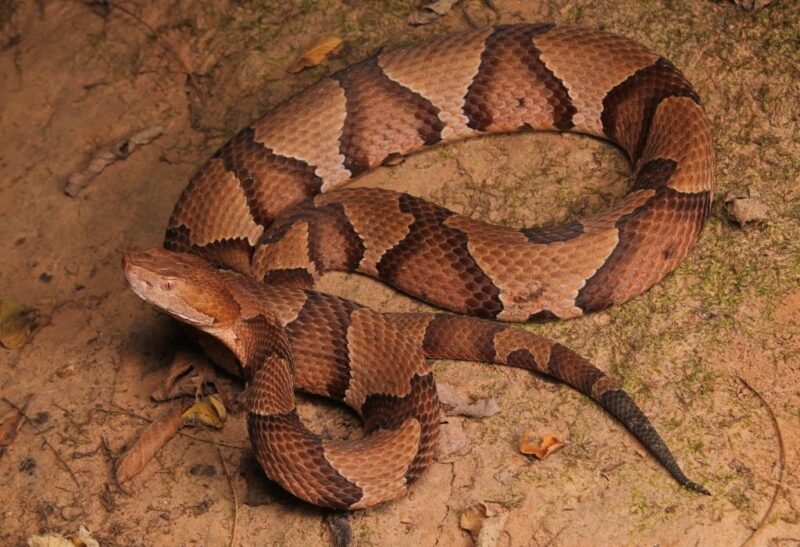Pennsylvania is one of the states with an abundance of wildlife – including a variety of snake species. As of writing, there are 21 recorded snake species in the state, six of which are water snakes. Do you want to learn more about water snakes in Pennsylvania? Keep on reading to find out.
So, what are the different water snakes in Pennsylvania? The six water snakes in Pennsylvania are the following:
- Kirtland’s Snake
- Northern Copperhead
- Northern Water Snake
- Ribbon Snake
- Queensnake
- Northern Rough Greensnake
Within this list, which ones are considered venomous? Which ones are non-venomous? Can a water snake hurt you? Are they aggressive by nature? These are just some of the questions that this article will answer. Read on for more information.
Table of Contents
Can a Water Snake Hurt You?

A water snake can hurt you. In general, most water snakes are categorized as non-aggressive and non-venomous. This means that they are not likely to attack humans without reason.
However, it must be stressed that water snakes are still snakes. They have fangs and are quite capable of biting humans if they feel like they’re in danger. Thus, non-venomous water snakes can still hurt you through their bites, which can also cause painful bite marks.
Additionally, venomous water snakes are dangerous. Aside from their painful bite, you will also suffer from swollen bite sites and severe allergic reactions from the venom. Fortunately, studies show that water snake venom is generally not fatal.
How Poisonous Is a Water Snake?

A majority of water snakes are not poisonous. However, those that are considered poisonous have venom that is not considered fatal.
It is also noted that some water snake venom can trigger allergic reactions, ranging from a simple swollen bite site to more severe muscle paralysis. But even then, these symptoms can be treated with prompt medical intervention.
6 Water Snakes in Pennsylvania
Kirtland’s Snake
The Kirtland’s snake is one of the six water snakes of Pennsylvania. This small snake is often found along creeks, ponds, ditches, and other damp habitats.
It is among the non-aggressive species of snakes, often choosing to hide or swim away when they sense danger nearby. The Kirtland’s snake is also non-venomous, so it poses no threat to humans. However, Kirtland’s Snake is currently listed as endangered and is protected by the state.
- Scientific Name: Clonophis kirtlandii
- Appearance: The Kirtland’s snake is a small snake species with slender bodies. It has also dark-colored scales with dot-like patterns along its sides. Its most notable feature is its orange or pink-colored underbelly.
- Color: Dark brown and slight reddish
- Lifespan: 5 years
- Length: 14 to 18 inches
- Diet: Earthworms, slugs, leeches, and small reptiles
- Place Of Origin: Illinois, Indiana, Northern Kentucky, Southern Michigan, Ohio, and Western Pennsylvania
- Venomous: No
Northern Copperhead

Of the six water snakes in Pennsylvania, only the Northern copperhead is known for being venomous. Technically, the Northern copperhead snake is a semi-aquatic being, which means that it can thrive on both land and water.
But, while this snake is venomous, studies show that the Northern copperhead snake bite is not fatal. Nevertheless, it can cause severe allergic reactions in some immunocompromised groups of people. Additionally, this snake is not aggressive. It is only known to attack if it has been stepped on or threatened.
- Scientific Name: Agkistrodon contortrix mokasen
- Appearance: The Northern copperhead is a large snake species with thick bodies covered in keeled scales. The scales on its body are reddish-brown or chestnut brown-colored, while its head is copper-colored, hence its name. This snake species is distinguishable by hourglass-shaped patterns across the length of its body. It has yellow eyes with vertical pupils.
- Color: Reddish-brown
- Lifespan: 18 years
- Length: 24 to 36 inches
- Diet: Rodents, reptiles, amphibians, small birds, and insects
- Place Of Origin: Eastern United States
- Venomous: Yes
Northern Water Snake

The Northern water snake is another non-venomous water snake in Pennsylvania. This large snake is sometimes called the common water snake due to its abundance across the United States.
What’s most notable about the Northern water snake is how its scales seem to change color when it’s dry and when it’s wet. When it’s dry, its scales are a solid color – often dark brown or black. But underwater, you can observe the full beauty of its scales, often showing light brown and brown-colored bands.
- Scientific Name: Nerodia sipedon
- Appearance: The Northern water snake is a large snake species with long and thick bodies. When wet, its scales appear to have light brown and dark brown bands, but it often appears as a solid dark color when it’s completely dry. Some Northern Water Snake species have square-shaped patterns over their scales instead of dark-colored bands.
- Color: Gray, tan, buff, and brown
- Lifespan: 9 years
- Length: 3.5 feet
- Diet: Primarily fish but also amphibians, insects, and rodents
- Place Of Origin: Central North America
- Venomous: No
Ribbon Snake
The ribbon snake is known for being a docile species. This non-venomous snake is a type of garter snake that’s common across the eastern side of North America.
Thanks to its slim body, the ribbon snake is noted for its impressive swimming speed. It has also been observed to climb trees, which is quite a feat for a water snake.
- Scientific Name: Thamnophis sauritus
- Appearance: Ribbon snakes have long and slim bodies covered in predominantly dark brown-colored scales. It has a pattern of yellow stripes along the length of its body. They are distinguished from other garter snakes due to their larger eyes and long faces.
- Color: Black and yellow stripes
- Lifespan: 10 to 11 years
- Length: 18 to 26 inches
- Diet: Amphibians and insects
- Place Of Origin: Eastern North America
- Venomous: No
Queensnake
Another semi-aquatic water snake is the Queensnake. This non-venomous snake is quite calm, so it’s not something you should feel threatened by. The Queensnake is among the most common water snake species across North America.
Interestingly, the Queensnake is so named because its scientific name is Regina septemvittata. Regina is Latin for “queen”.
- Scientific Name: Regina septemvittata
- Appearance: Queen snakes have long slim bodies with predominantly brownish to olive-green scales. It has a yellowish or cream stripe on its side, which makes it easy to distinguish from garter snakes. It has a small head with round-shaped eyes.
- Color: Brownish, olive-green, yellow, and cream
- Lifespan: 19 years
- Length: 15 to 24 inches
- Diet: Mainly crayfish and occasionally fish and tadpoles
- Place Of Origin: North America
- Venomous: No
Northern Rough Greensnake

The Northern rough greensnake is another non-venomous water snake in Pennsylvania. This snake species frequents marshy areas but is often seen slithering along branches and vines. The Northern rough greensnake primarily preys on insects, which means that it is not likely to attack humans.
While it’s quite rare to spot this snake species, it is not listed as threatened or endangered. The reason why it’s rarely spotted is due to the green color that allows it to blend easily with nature’s green foliage.
- Scientific Name: Opheodrys aestivus aestivus
- Appearance: As its name implies, the Northern rough greensnake has solid green color throughout the length of its body. Only its underbelly can either be yellow or cream-colored. It has a long and slender body with a small head and two round-shaped eyes.
- Color: Light green
- Lifespan: 8 years
- Length: 32 inches
- Diet: Insects
- Place Of Origin: Southern Canada, Northern Mexico
- Venomous: No
Water Snake Characteristics
Currently, there are about 200 known species of water snakes. Most of these species share common characteristics like round-shaped heads, slender bodies, and round-shaped pupils.
Rounded Heads
It has been observed that most water snakes, especially the non-venomous kind, have narrow yet rounded heads. This is as opposed to venomous ones with bulkier head sizes. Also, some land snakes have distinctive diamond or triangle-shaped heads.
Slender Bodies with Flat Tails
Water snakes have slender bodies. These longer yet slimmer bodies allow them to move fast, especially when swimming underwater. Also, most water snakes have an almost flat tail. This allows them to navigate the waters with ease.
Round Pupil Shape
Most water snakes have noticeably round pupils, giving them a more friendly look. However, this is only true for non-venomous species. Those that are venomous have elliptical pupils. Thus, looking into the snake’s pupil shape will help you determine whether it’s venomous or not – and this applies to both land and water species.
Non-Aggressive
In terms of their temperament, water snakes are quite docile towards humans. If you don’t do anything to provoke them, then they will simply swim away.
Frequently Asked Questions
Are Sea Snakes Aggressive?
Sea snakes are not known to be aggressive. In general, these snake species prefer to hide or slip away when they sense danger nearby. However, if they are provoked or threatened, they are known to fight back to defend themselves.
What Happens if You Get Bit by a Sea Snake?
In general, most sea snakes are non-venomous. Their bites may be painful, but they will only leave a mark at most.
On the other hand, a bite from venomous sea snake species can cause quite a reaction, including headaches, muscle stiffness, and muscle pain, and can even lead to paralysis. This is in addition to the pain and swelling around the bite area.
What Do You Do if You See a Sea Snake?
If you ever come across a sea snake, it’s best to just let them be. They are non-aggressive by nature, so they would simply swim by without attacking anyone. In contrast, if you try to shoo them away, they might end up attacking you since they might feel like they’re in danger.
Which Sea Snake Is the Most Poisonous?
Out of the many sea snake species, the Dubois sea snake is considered the most poisonous. Studies reveal that its venom is quite lethal, making it the third most venomous snake in the world after the Inland Taipan and the Eastern brown snake, both of which are land snakes.
Except for the Northern copperhead, all other sea snake species in the state are considered non-venomous. But even then, their bites can still be quite painful. So to be safe, it’s best to allow these snakes to simply swim away if you ever encounter one. After all, they are only known to attack if you’re the first one to show aggression.
List of Sources
Northern Copperhead. Smithsonian’s National Zoo & Conservation Biology Institute.
Dewey, T. (2008). Regina septemvittata. Animal Diversity Web.
Willson, J. D. Rough Green Snake (Opheodrys aestivus). Savannah River Ecology Laboratory.
Fuehrer, J., Kong, E. L., Murphy-Lavoie, H. M. (2022). Sea Snake Toxicity. StatPearls Publishing.
